Last week, synagogues across America marked the 100-year anniversary of the first official bat mitzvah. The ceremony occurred on March 18, 1922 and was created by Rabbi Mordechai Kaplan, the founder of Reconstructionist Judaism, to welcome his12-year-old daughter, Ruth, into the family of Jewish adults. While that sounds like a long history, it pales alongside the roughly 1,000-year longevity of the bar mitzvah. Moreover, it took almost 60 years for the bat mitzvah ceremony to attain equal stature with the bar mitzvah at synagogues in the U.S.
To explore this evolution — and what it says about the role of women and girls in Judaism — assistant JLC education director Lily Lucey invited Shomrei women of several generations on Sunday, March 19 to recount for the b’nai mitzvah classes what the bat mitzvah represented when they were 12 or 13.
Almost 40 years after Ruth Kaplan’s ceremony, Aileen Grossberg explained, having a bat mitzvah at her family’s Conservative synagogue in Lowell, MA was beyond her dreams. In the late 1950s, when , she reached the age of Jewish adulthood, she recalled, “We girls didn’t question the status quo but instead just watched and listened as our brothers practiced for the big day.”
This was despite her status as the top student in her Hebrew school and her own deep, spiritual and intellectual connection to Judaism. “I accompanied either my father or grandfathers to services almost every Shabbat and holidays,” she said. One of her grandfathers founded the synagogue and her father was president for several years. As a little girl, she loved twisting and braiding their tzitzit as they davened. She remembers the bima as looming high above her, with at least eight steps. “It was both mystical and awe-inspiring,” she said. And unattainable.
“I went up on the bima the first time when I won a writing award at age 17; the next time I went up on the bima was on my wedding day,” Aileen recalled.
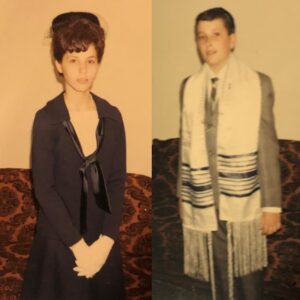 In the mid-1960s, Sarita Eisenberg celebrated her bat mitzvah at her family’s conservative synagogue in Lakewood, NJ. She remembers the ceremony as much for what didn’t happen as what did. It was not yet common to have a bat mitzvah in the US generally, and particularly at Ahavat Shalom.
In the mid-1960s, Sarita Eisenberg celebrated her bat mitzvah at her family’s conservative synagogue in Lakewood, NJ. She remembers the ceremony as much for what didn’t happen as what did. It was not yet common to have a bat mitzvah in the US generally, and particularly at Ahavat Shalom.
“My sister Marion – two years older – had not thought to have one,” she said. But Sarita had a twin brother, Howard, who was preparing for his bar mitzvah, “and having a bat mitzvah felt important to me.” In fact, she wanted to have her bat mitzvah at age 12, the age of adulthood for Jewish girls, but her parents said she had to wait to share the day with Howard at age 13.
“Although scheduled on the same weekend, we did not really share the day,” Sarita recalled. “I went up on the bima to chant the Haftorah during the Friday night service ― I don’t recall when during the service it was fit in ― while Howard donned a tallit to be called up for an aliyah during the Shabbat morning service. He also chanted the Haftorah. He could have read from the Torah and led the service, but he chose not to. Neither of those was an option for me.”
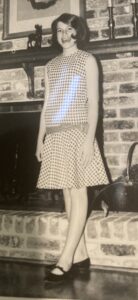 Dale Russakoff also became a Jewish adult in the mid-1960s, but the rabbi at her “very Reform” synagogue in Birmingham, AL, would not allow any girl to have a bat mitzvah. Dale doesn’t recall questioning this, even though her Conservative girlfriends had Friday night bat mitzvah ceremonies like Sarita’s, and she now wishes she could ask her rabbi for his reasoning. The Birmingham church bombing was in the recent past at the time, and the Ku Klux Klan remained active, so she wonders if the congregation’s leaders felt it was safer for Jews not to draw more attention to themselves than was necessary.
Dale Russakoff also became a Jewish adult in the mid-1960s, but the rabbi at her “very Reform” synagogue in Birmingham, AL, would not allow any girl to have a bat mitzvah. Dale doesn’t recall questioning this, even though her Conservative girlfriends had Friday night bat mitzvah ceremonies like Sarita’s, and she now wishes she could ask her rabbi for his reasoning. The Birmingham church bombing was in the recent past at the time, and the Ku Klux Klan remained active, so she wonders if the congregation’s leaders felt it was safer for Jews not to draw more attention to themselves than was necessary.
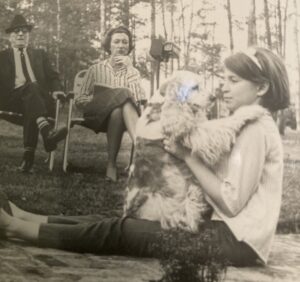 Another possible reason was that Reform Jews in that era seemed at least as committed to assimilation as to Judaism. The service at Temple Emanuel was almost entirely in English and included an organ and choir. The only person who wore a kippa or tallit was the rabbi himself. And on most Saturdays in the fall, when Alabama or Auburn played football at Birmingham’s Legion Field—“the Football Capital of the South”–he truncated his sermon so that everyone, himself included, could be there in time for the kickoff. In retrospect, it seems unlikely that he would’ve encouraged girls to commit themselves demonstrably to Judaism.
Another possible reason was that Reform Jews in that era seemed at least as committed to assimilation as to Judaism. The service at Temple Emanuel was almost entirely in English and included an organ and choir. The only person who wore a kippa or tallit was the rabbi himself. And on most Saturdays in the fall, when Alabama or Auburn played football at Birmingham’s Legion Field—“the Football Capital of the South”–he truncated his sermon so that everyone, himself included, could be there in time for the kickoff. In retrospect, it seems unlikely that he would’ve encouraged girls to commit themselves demonstrably to Judaism.
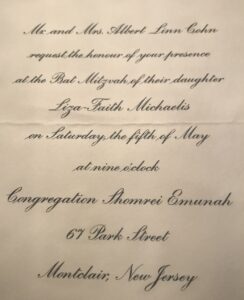 Over a decade later, and more than 55 years after Ruth Kaplan, Liza Cohn celebrated her bat mitzvah in 1979 at Shomrei Emunah. “What strikes me most about my bat-mitzvah is that I have no recollection what my Torah portion was!” she said. She did read from the Torah, but no one helped her study the meaning of her parasha. “Rabbi Schnitzer was a lovely man, but never once did he meet with me to discuss the passage I worked hard to recite in Hebrew,” she said. “Without any judgment, Rabbi Schnitzer told me that he had prepared my d’var Torah and all I had to do was read it.”
Over a decade later, and more than 55 years after Ruth Kaplan, Liza Cohn celebrated her bat mitzvah in 1979 at Shomrei Emunah. “What strikes me most about my bat-mitzvah is that I have no recollection what my Torah portion was!” she said. She did read from the Torah, but no one helped her study the meaning of her parasha. “Rabbi Schnitzer was a lovely man, but never once did he meet with me to discuss the passage I worked hard to recite in Hebrew,” she said. “Without any judgment, Rabbi Schnitzer told me that he had prepared my d’var Torah and all I had to do was read it.”
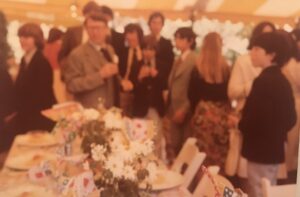 “I have a vivid memory standing on the bimah, in my long pink dress with the high frilly collar, in front of the open Torah scroll and perfectly chanting the lines I had worked diligently to learn by listening, over and over and over, to a cassette prepared for me by the cantor.” Liza recalled. “I had no clue what I was reading, but it sounded good.”
“I have a vivid memory standing on the bimah, in my long pink dress with the high frilly collar, in front of the open Torah scroll and perfectly chanting the lines I had worked diligently to learn by listening, over and over and over, to a cassette prepared for me by the cantor.” Liza recalled. “I had no clue what I was reading, but it sounded good.”
All of the participants said their Jewish observance has changed in the decades since they turned 12 and 13. Aileen had her first aliyah at Shomrei Emunah, as a young mother, and counted it as an unofficial bat mitzvah. But she wore neither a kippah nor a tallit. She taught religious school for many years and always emphasized that the girls should have the same responsibilities as the boys. “When we would daven, pray, in class I’d put on a kippa and my daughter’s tallit to lead the little service,” she said. “Yes, both of my daughters had their bat mitzvah ceremonies at Shomrei although only my younger daughter had a tallit. Times change quickly.”
Aileen bought her first tallit at a Jewish craft fair, but it remained in her car, unworn, for many years. Then, a few days after her sixtieth birthday, her father died. “This seemed to be a turning point in my spiritual life,” she said. “All the men beside whom I had sat in synagogue and whose tallitot had enfolded me as a child were gone. I had no one’s tzitzit to twist and braid. I began wearing my tallit at the first shiva minyan for my father and have continued to do so ever since.”
Her father’s funeral in 2004 was the last one held in her childhood synagogue, which had been sold to a Christian church and school.
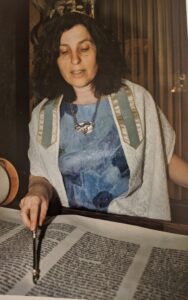 Sarita first donned a tallit and chanted an aliyah much sooner than Aileen, but still it wasn’t until 13 years after her bat mitzvah. She first read Torah about ten years after that. And it was 40 years later that she and her brother Howard ascended the bima together for the maftir aliyah and shared the chanting of the Haftorah.
Sarita first donned a tallit and chanted an aliyah much sooner than Aileen, but still it wasn’t until 13 years after her bat mitzvah. She first read Torah about ten years after that. And it was 40 years later that she and her brother Howard ascended the bima together for the maftir aliyah and shared the chanting of the Haftorah.
Liza recalled returning to Shomrei’s bima for an aliyah 30 years after her bat mitzvah, but from a different vantage point. “My father had recently passed away, and he was now a name on a plaque with a lighted bulb next to it. And I was the parent reciting a blessing over my son, the bar mitzvah” she said. “Only in that moment did I understand how Judaism would hold my family together through the generations.”
Neither Dale nor Liza owns a tallit to this day, although they don them when on the bima, as is Shomrei’s custom. Dale first read from the Torah at her older son’s bar mitzvah but has never had a bat mitzvah. Sarita noted during the 100th anniversary discussion that even now, boys wear kippot inside Shomrei, but girls do not. “For boys, it’s an obligation. For girls it’s a choice,” she said. “It’s still not egalitarian.”
NOTE: To read more about experiences of men and women and their relationships to tallit, Aileen recommends Every Tallit Tells a Tale, edited by Debra Smith. Aileen chronicled her own experience in one of the essays, “A Momentous Decision.”
- Seeing the Other - Thu, Dec 14, 2023
- Helping Families Facing Homelessness - Thu, Sep 29, 2022
- A Stronger and Holier Community - Thu, Jun 23, 2022

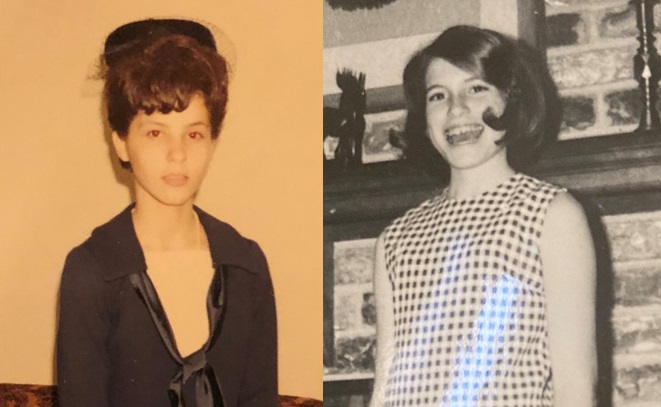
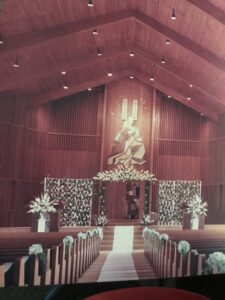
I enjoyed your article greatly. In the 50s, I shared what they called a Bat Mitzvah with 14 other girls at a Sunday morning service. We did not chant Haftorah or Torah. We read some English and Hebrew prayers, had Kiddish at Shul, and each returned home with all our relatives for a nice party. My grandfather founded Congregation Sons of Israel Synagogue in Peabody, MA in 1909. My mother was in the first Hebrew School class over my grandfather’s shoe store. I, like Aileen, used to love to sit next to my father as he dovened and play with his tzitzit. I first chanted a Haftorah at Shomrei in 1987. In 1991, I had prepared a Torah portion for Shomrei. My father had a heart attack, so I was in Peabody and asked to chant my Torah portion. They still did not allow women to have aliyahs. I was allowed to chant my Torah portion after they finished the Torah service, I had my back to the congregation. I was told that many left the room.
I learned so much from this article about the personal evolution of women in my cohort at Shomrei choosing to embrace egalitarian Judaism one step at a time. We should never take our ability to more completely participate in the rites and rituals for granted.
What an interesting article, Dale. It brings back memories of my bat mitzvah in the late ’70’s on a Friday night at our Miami synagogue. I remember wearing a black velvet pinafore and groovy black patent leather high(ish) heel Mary Janes. I did not wear a tallit until I made one to wear at Sam’s bar mitzvah. I love the uniqueness of it as it reminds me of my family and our connection to the Shomrei community.
Thanks, Dale. Like Liza Cohn, even in Hebrew school at Shomrei we learned to read Hebrew really well but without comprehension. (I compare it to a five year old who can read the words of the NY Times but has no idea what they mean.) Still, I was grateful to have a bat mitzvah at Shomrei with Rabbi Schnitzer and Cantor Levine. Unlike Liza, I did do a dvar but all I remember of it was comparing the portion I read to something about Abe Lincoln. And, in my crushed velvet sky blue dress, my parents allowed me to drink coffee for the first time at my bat mitzvah reception, so that truly made me an “adult.”